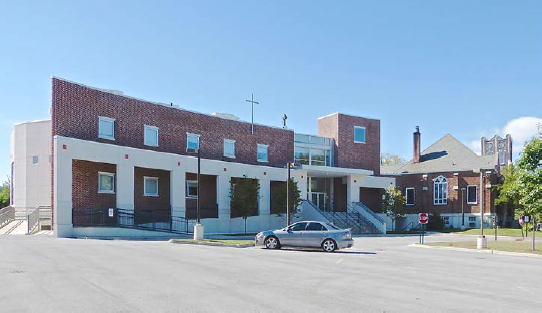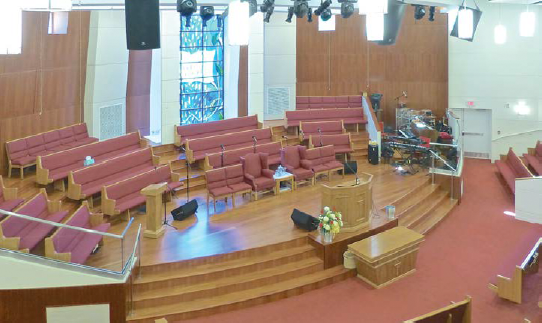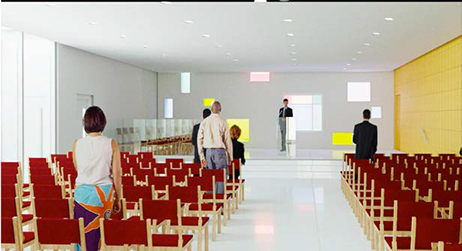How Versatile Campuses Connect Faith Communities
by Victor Body-Lawson, AIA,
Body Lawson Associates Architects and Planners
A music studio. A community center. A coffee shop. What do these places have in common? In the coming years, they might all have a religious organization or house of worship as their landlord.
With membership in faith communities plummeting—a recent Gallup report showed a decrease of 20 percent in church membership over the last two decades, with many people who identify themselves as “religious” less likely than ever to belong to a place of worship—some faith-community leaders are looking for ways to reinvigorate their congregations while building growth opportunities for the future. Many are considering how buying additional land or redeveloping existing sites into mixed-use campuses could reignite their membership—and secure the future of a robust, faith-based community around them.
Congregation leaders willing to think creatively in this way, and share their land and buildings with community partners, stand to benefit from not only upgraded facilities, but also from new income streams. For stand-alone houses of worship where redevelopment isn’t feasible, designing multipurpose rooms and secular environments will help place them in a strong position to adapt to the changing needs of their congregations and neighborhoods.
Based on recent work with several inventive and future-focused churches, our firm, Body Lawson Associates, has seen that ideas we’ve applied to mixed-use and residential developments have shaped the investments of religious clients. Two of our recent projects exemplify the approaches that are becoming more common around the United States.
Senda Apartments: Affordable Housing Meets Church Community
When the pastor of Iglesia de Dios Senda de Bendicion was looking to redevelop his site in the Mott Haven neighborhood of the Bronx, New York, he reached out to a nonprofit developer, South Bronx Overall Economic Development Corporation (known as SoBro). The two found a heavenly match: Plans for a new mixed-use project that would see the outdated church—adapted from a commercial building— demolished and a six-story affordable housing project erected in its place. And on the ground floor? A new church facility for Senda de Bendicion, three times the size of its original.
Housed within a 40-unit affordable housing building, the church portion of the project consists of 6,745 square feet of worship and support space, located in the basement and first floor. The below-grade areas include a fellowship hall, kitchen with pantry, as well as mechanical and storage spaces for Senda de Bendicion. The first floor includes the sanctuary and narthex as well as the pastor’s offices and other administrative and support spaces. The overall building is tracking to meet or exceed LEED Gold certification.
For Senda de Bendicion, this means brand new facilities—including a state-of-the-art audiovisual room—and foot traffic from the building’s residents that point to a larger, stronger community.
To integrate the church into its surroundings, we designed the main sanctuary using a simple white box as inspiration. The partí presents a large, bright, inviting room used not only for services but also for meetings or other community events. To achieve this, the sanctuary is fitted out with two foundational components in mind: a flat floor and a stage. Also featuring abundant windows and a flat ceiling, this versatile space can be used for dance and other performances, and it can be rented out to other groups and religious organizations when the Senda community is not utilizing it.
In addition to the main sanctuary, we also designed a fellowship hall on the lower level, replete with its own entrance, which is adjacent to the community room of the residential building. In this way, the church also enjoys access to additional square footage should it need to expand. Additionally, the designed facility includes a technologically advanced audiovisual room to serve as a recording studio for the two main rooms situated right off the main sanctuary. This room also features a viewing panel into the main sanctuary.
The value of this redevelopment plan for Senda de Bendicion has been twofold: Not only has the congregation benefited from larger, upgraded facilities; it can also leverage these spaces to offer events and services that could invite newcomers to join them and help them grow. Without raising a dime, the church generated a turnkey project that has secured their future for years to come.
A residential mixed-use project such as Senda is just one way that churches can partner with developers to grow. Commercial mixed-use projects hold much potential as well, allowing churches, synagogues, and mosques to transform parts of their facilities into revenue-generating concepts like co-working spaces, workshops for local artisans, or even community yoga or dance studios. One Catholic church in Zimbabwe created a state-of-the-art studio that it rents out to both gospel and secular musicians. If church leaders can think creatively, the possibilities are endless.
Union Baptist Church: Creating Forward-Thinking Facilities

The new addition at Union Baptist Church provides accessibility throughout the church campus’s buildings. Photo: Courtesy of Body-Lawson Associates
Located in White Plains, New York, Union Baptist Church offers an example of a stand-alone church equipped with the necessary infrastructure to expand its community offerings and adapt to future needs.
Built in 1929, the small church had become antiquated and was in need of an upgrade to help it more appropriately welcome in a new generation of members. In a multi-phase transformation that included new, ground-up construction, Union Baptist Church (UBC) leaders built a state-of-the art sanctuary designed by our firm to accommodate congregation members in an amphitheater-type hall with full stage lights and an upper level, in addition to the original church structure. The design concept then connected the buildings with walkways and paths to make the grounds accessible for all, including those with limited mobility or using wheelchairs.

New Union Baptist Church sanctuary ‘theater’ stresses versatility for community-based events. Photo: Courtesy of Body-Lawson Associates
We and UBC approached the design of the sanctuary similar to that of a theater, with lighting that can be modulated and adapted to different scenes. As with the Senda de Bendicion project, UBC chose to integrate an advanced audiovisual room that is connected to the main sanctuary. A big reason for this was to give the church the ability to create content for social media and help attract members, which in light of the Covid-19 pandemic has become an increasingly urgent need for churches.
The result is a versatile church campus, featuring a congregation hall that can be used not only for services but also for meetings, or potentially events or concerts held by outside groups. In the future, UBC can rent out this space if needed to create an additional income stream.
An important feature of UBC’s new sanctuary is the lobby, which is large and open and was designed with events and meetings in mind. The next phase of the project will include a family life center, complete with classrooms and reading rooms, as well as a bookstore and potential café. With these additions, UBC has created the infrastructure necessary to be able to adapt to future community needs and attract the next generation of members – Millennials and Gen Z congregants – for whom technology and community is undoubtedly more important than in generations past.
In the words of a Millennial herself, Faith It reporter Sam Eaton speaks plainly and directly about why “it isn’t a big deal” for most young people to leave the church behind. She also offers a solution, one of several: “Find ways to connect with neighbors within the community.” Developing a mixed-use campus or retrofitting existing facilities into more versatile spaces give churches the means to do just that. As we design more flexibility into our churches, they will be better suited to adapt to the future needs of learning, communication, technologies, and beliefs of our fast-paced world.
AUTHOR NOTE
The author is a Nigerian-born architect, educator, and artist based in New York City. He founded Body Lawson Associates Architects and Planners (blarch.com), an acclaimed architecture, interiors, and urban design practice operating in the U.S. and globally, in 1993. He is an active member of the American Institute of Architects and the National Organization of Minority Architects.

